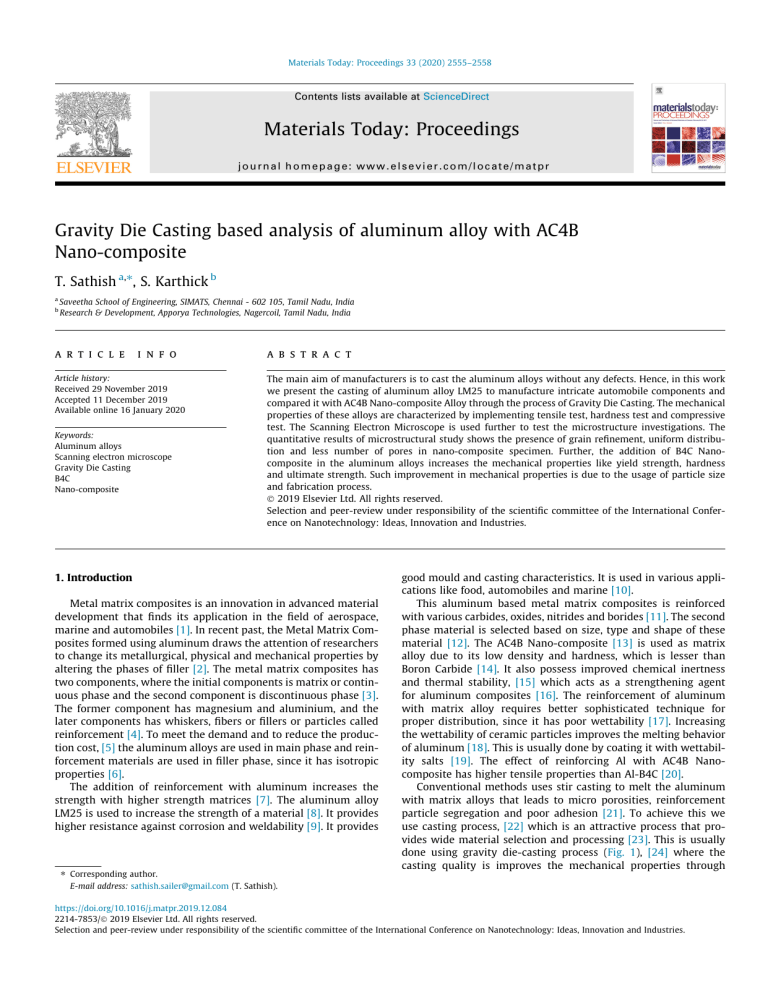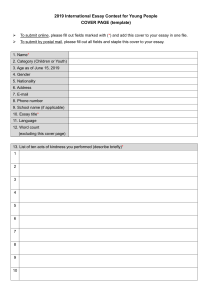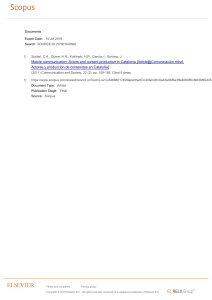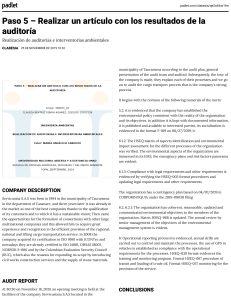ravity Die Casting based analysis of aluminum alloy with AC4B Nano-composite
Anuncio

Materials Today: Proceedings 33 (2020) 2555–2558 Contents lists available at ScienceDirect Materials Today: Proceedings journal homepage: www.elsevier.com/locate/matpr Gravity Die Casting based analysis of aluminum alloy with AC4B Nano-composite T. Sathish a,⇑, S. Karthick b a b Saveetha School of Engineering, SIMATS, Chennai - 602 105, Tamil Nadu, India Research & Development, Apporya Technologies, Nagercoil, Tamil Nadu, India a r t i c l e i n f o Article history: Received 29 November 2019 Accepted 11 December 2019 Available online 16 January 2020 Keywords: Aluminum alloys Scanning electron microscope Gravity Die Casting B4C Nano-composite a b s t r a c t The main aim of manufacturers is to cast the aluminum alloys without any defects. Hence, in this work we present the casting of aluminum alloy LM25 to manufacture intricate automobile components and compared it with AC4B Nano-composite Alloy through the process of Gravity Die Casting. The mechanical properties of these alloys are characterized by implementing tensile test, hardness test and compressive test. The Scanning Electron Microscope is used further to test the microstructure investigations. The quantitative results of microstructural study shows the presence of grain refinement, uniform distribution and less number of pores in nano-composite specimen. Further, the addition of B4C Nanocomposite in the aluminum alloys increases the mechanical properties like yield strength, hardness and ultimate strength. Such improvement in mechanical properties is due to the usage of particle size and fabrication process. Ó 2019 Elsevier Ltd. All rights reserved. Selection and peer-review under responsibility of the scientific committee of the International Conference on Nanotechnology: Ideas, Innovation and Industries. 1. Introduction Metal matrix composites is an innovation in advanced material development that finds its application in the field of aerospace, marine and automobiles [1]. In recent past, the Metal Matrix Composites formed using aluminum draws the attention of researchers to change its metallurgical, physical and mechanical properties by altering the phases of filler [2]. The metal matrix composites has two components, where the initial components is matrix or continuous phase and the second component is discontinuous phase [3]. The former component has magnesium and aluminium, and the later components has whiskers, fibers or fillers or particles called reinforcement [4]. To meet the demand and to reduce the production cost, [5] the aluminum alloys are used in main phase and reinforcement materials are used in filler phase, since it has isotropic properties [6]. The addition of reinforcement with aluminum increases the strength with higher strength matrices [7]. The aluminum alloy LM25 is used to increase the strength of a material [8]. It provides higher resistance against corrosion and weldability [9]. It provides ⇑ Corresponding author. good mould and casting characteristics. It is used in various applications like food, automobiles and marine [10]. This aluminum based metal matrix composites is reinforced with various carbides, oxides, nitrides and borides [11]. The second phase material is selected based on size, type and shape of these material [12]. The AC4B Nano-composite [13] is used as matrix alloy due to its low density and hardness, which is lesser than Boron Carbide [14]. It also possess improved chemical inertness and thermal stability, [15] which acts as a strengthening agent for aluminum composites [16]. The reinforcement of aluminum with matrix alloy requires better sophisticated technique for proper distribution, since it has poor wettability [17]. Increasing the wettability of ceramic particles improves the melting behavior of aluminum [18]. This is usually done by coating it with wettability salts [19]. The effect of reinforcing Al with AC4B Nanocomposite has higher tensile properties than Al-B4C [20]. Conventional methods uses stir casting to melt the aluminum with matrix alloys that leads to micro porosities, reinforcement particle segregation and poor adhesion [21]. To achieve this we use casting process, [22] which is an attractive process that provides wide material selection and processing [23]. This is usually done using gravity die-casting process (Fig. 1), [24] where the casting quality is improves the mechanical properties through E-mail address: sathish.sailer@gmail.com (T. Sathish). https://doi.org/10.1016/j.matpr.2019.12.084 2214-7853/Ó 2019 Elsevier Ltd. All rights reserved. Selection and peer-review under responsibility of the scientific committee of the International Conference on Nanotechnology: Ideas, Innovation and Industries. 2556 T. Sathish, S. Karthick / Materials Today: Proceedings 33 (2020) 2555–2558 2.1.1. Aluminum alloy (LM25) The tensile properties of LM25 at elevated temperatures is influenced mainly by the heat reaction condition of the gravity die casting [38]. The alloy after heat treatment has higher resistance against attack either by marine atmosphere or salt water [39]. Hence, it is considered to exhibit better machining properties [40]. 2.1.2. Aluminum oxide (or) alumina The Al2O3 is formed of a chemical mixture of oxygen and aluminum and this is said to exhibits high thermal conducting using its ceramic properties [41]. The hardness properties of Al2O3 increases the hardness properties, [42] which is used for abrasive and can be used as cutting tool [43]. The properties of Al2O3 Compositions is given in Table.1 [44]. 2.2. Properties of metals and matrix material Fig. 1. Gravity Die Casting Machine. solidification [25]. This process increases the characteristics of diecasting of Al alloys [26]. In this paper, we propose casting of aluminum alloy LM25 to manufacture intricate automobile components and compared it with AC4B Nano-composite Alloy through the process of Gravity Die Casting [27]. The mechanical properties of these alloys are characterized by implementing tensile test, hardness test and compressive test [28]. The Scanning Electron Microscope is used further to test the microstructure investigations. 2. Experimental procedure The present work reinforces aluminum (Fig. 2(a)) with AC4B nano-composite (Fig. 2(b)) with a density of 2.66 g/cm3 [29]. The reinforcement nano-composite particles possess good fluidity with excellent pressure tightness, [30] good hot tear resistance, [31] good machinability, [32] high corrosion resistance, [33] good castability, [34] and high specific strength [35]. It further provides various other properties like high strength, low density, neutron absorption capability, good chemical stability, extremely high hardness and chemical composition, where the chemical composition analysis was carried out using optical emission spectrometer [36]. The Al alloys are melted in furnace with crucible dish made of graphite. At the time of charging, the melting losses are considered by the furnace [45]. The test rachlotne structure is used to degasificate the molten alloy [46]. The motel metal is now allowed to cool below its melting point to convert it from molten state to solid state [47]. Then the liquid melt is added with preheated (400 °C) matrix material [48]. Manual stirring of molten alumina (Al2O3) and B4C takes place in the crucible dish and it is thoroughly stirred [49]. After the stirring process, the semisolid molten metal is reheated to liquid state inside the furnace and then automatic stirring takes place in the material about 10 times at the speed of 550 rpm, which uniformly distributes the additives [50]. The grain size refinement is affirmed by linear intercept method to be in transverse nature and its SEM analysis result is given in Fig. 2. The ultimate tensile strength, yield strength, percentage elongation is given in Fig. 3. As the alloy density level increases, the strength of the material increases, as both the parameters are directly proportional to each other. Table 1 Properties of Al2O3 Compositions. 2.1. Material composition The materials alloy used in the present study are LM25 aluminum alloy and AC4B nano-composite particles [37]. Fig. 2. SEM analysis (a) LM25; (b) AC4B. Properties Al2O3 Theoretical density Thermal expansion Thermal conductivity (298 K) Grain size Flexural strength Young’s modulus Fracture toughness (KIC) Hardness Fracture threshold (KI0) 3.98 g/cm3 9.8106/°C 36 W/mK 1.7 lm 630 MPa 407 GPa p 3.2 MPa m 20 GPa p 2.4 MPa m T. Sathish, S. Karthick / Materials Today: Proceedings 33 (2020) 2555–2558 2557 3. Results and discussion The results of various structural parameters like metallurgical structure, hardness test, tensile strength, and elongation are analysis in for the proposed composite. The results of which is given below: 3.1. Metallurgy structure In microstructural analysis, the most important element is the grain size that plays a major role in metallurgical structure. The gravity die casting microstructure LM25 alloy sample is shown in Fig. 4 and gravity die casting microstructure AC4B nanocomposite alloy is shown in Fig. 5. The size of the structure of grains are desirable that leads to improvement of tear resistance, mechanical properties and pressure tightness. In LM25 alloys, the grains are packed loosely using Scanning Electron Microscope (SEM). The grains that are loosely packets leads to shrinkage defects or porosity. The aluminum alloy (AC4B) has 3–5% grains and that acts as a grain refiners in order to grow more. The C4B in AC4B alloy enables the grains to closely occur with each other in the form of a refiner, which is given below: Fig. 4. Metallurgical structure of LM25. Al þ C4B ! a - Al alloy solid solution The availability of defects is not seen in AC4B alloy due to good grain structure and closed packet grains. The LM25 alloy performs with lesser optimal mechanical properties than AC4B alloy. The porosity seen in the microstructure is not seen in the alloy surface, which is located in minimal quantity at the time of gravity die casting. Additionally, the yield strength in nano-composite material increases and this is examined through SEM. Further, the ultimate strength increases with the addition of C4B through the microstructure analysis. The results obtained from the Ultimate tensile strength, Yield strength, elongation is given in Table 2. The samples are tested using Brinell hardness test. This test uses a ball shaped indenter, which is made of hardened tungsten with a diameter of 5 mm and applied load is given as 250 Kef. The result shows that AC4B alloy has maximum hardness in all trails. Increasing the hardness with C4B samples, 5% volume composite content of C4B performs minor hardness than sample of 2% volume. This is due to existence of porous region with high level of C4B. The percentage of elongation measures the ability of a compound to expand its breaking point. The proposed method uses measures the elongation of LM25 and this is lesser than grain Fig. 5. Metallurgical structure of AC4B. refinement and ductile property [51]. The C4B nanocomposite is then tested and it confirms the LM25 addition with C4B nanocomposite for improving the elongation property. The bonding element Fig. 3. Strength Analysis (a) Ultimate Tensile Strength; (b) Yield Strength. 2558 T. Sathish, S. Karthick / Materials Today: Proceedings 33 (2020) 2555–2558 Table 2 Tensile Strength Parameter. Test Parameters Aluminum Alloy (LM25) Nano Composite Particle (AC4B) Ultimate Tensile strength Yield Strength Elongation 281 220 6 286 222 2.5 between the LM25 alloys is not broken by stir casting. Additionally, the electromagnetic bonding in C4B increases the percentage of elongation and C4B during this time acts as an elastic component with Al. The proposed design is tested finally in a 3 point flexural testing machine in order to measure the flexural test and this is tested against ASTM:E290 Standard with the cut specimen. The result shows that proposed design performs well than LM25. 4. Conclusion In this paper we reinforce AC4B nanocomposite in aluminum alloy LM25, which is fabricated using AC4B through the process of Gravity Die Casting. The study visualizes the changes associated with alloys at each stage and the values of ultimate tensile strength, yield strength and hardness is noted. It is seen that the present study significantly improves the mechanical properties of aluminum alloy LM25 due to reinforcement of AC4B nanocomposite. There are other tests carried out to check the possible extent of enhancement in LM25 mechanical properties. The results shows that proposed nanocomposites obtained improved enhancement in its mechanical properties. In future, the LM25 alloy can be reinforced with polymer nanocomposites and its mechanical strength can be tested. Declaration of Competing Interest The authors declare that they have no known competing financial interests or personal relationships that could have appeared to influence the work reported in this paper. References [1] B. Radha Krishnan, V. Vijayan, T. Parameshwaran Pillai, T. Sathish, Trans. Canadian Soc. Mech. Eng. 43 (2019) 509–514. [2] G.K. Nagesha, V. Dhinakaran, M. Varsha Shree, K.P. Manoj Kumar, Damodar Chalawadi, T. Sathish, Mater. Today Proc. 21 (2020) 916–919, https://doi.org/ 10.1016/j.matpr.2019.08.158. [3] K. Gurusami, D. Chandramohan, S. Dinesh Kumar, M. Dhanashekar, T. Sathish, Mater. Today Proc. 21 (2020) 981–987, https://doi.org/10.1016/ j.matpr.2019.09.141. [4] Krishnaswamy Haribabu, Muthukrishnan Sivaprakash, Thanikodi Sathish, Arockiaraj Godwin Antony, Venkatraman Vijayan, Thermal Sci. (2019), https://doi.org/10.2298/TSCI190409397K. [5] M. Dhanashekar, P. Loganathan, S. Ayyanar, S.R. Mohan, T. Sathish, Mater. Today Proc. 21 (2020) 1008–1012, https://doi.org/10.1016/j.matpr.2019.10.052. [6] M. Swapna Sai, V. Dhinakaran, K.P. Manoj Kumar, V. Rajkumar, B. Stalin, T. Sathish, Mater. Today Proc. 21 (2020) 948–953, https://doi.org/10.1016/ j.matpr.2019.09.027. [7] Muthukrishnan Sivaprakash, Krishnaswamy Haribabu, Thanikodi Sathish, Sundaresan Dinesh, Venkatraman Vijayan, Thermal Sci. (2019), https://doi. org/10.2298/TSCI190419398M. [8] K. Muthukumar, R.V. Sabariraj, S. Dinesh Kumar, T. Sathish, Mater. Today Proc. 21 (2020) 976–980, https://doi.org/10.1016/j.matpr.2019.09.140. [9] R. Praveen Kumar, P. Periyasamy, S. Rangarajan, T. Sathish, Mater. Today Proc. 21 (2020) 504–510, https://doi.org/10.1016/j.matpr.2019.06.646. [10] S. Dinesh Kumar, D. Chandramohan, K. Purushothaman, T. Sathish, Mater. Today Proc. 21 (2020) 876–881, https://doi.org/10.1016/j.matpr.2019.07.710. [11] S. Dinesh Kumar, K. Purushothaman, D. Chandramohan, M. Mohinish Dushyantraj, T. Sathish, Mater. Today Proc. 21 (2020) 263–267, https://doi. org/10.1016/j.matpr.2019.05.426. [12] S. Karthick, S. Perumal Sankar, T. Raja Prathab. In 2018 International Conference on Emerging Trends and Innovations in Engineering And Technological Research (ICETIETR), (2018) 1–7. [13] S.P. Palaniappan, K. Muthukumar, R.V. Sabariraj, S. Dinesh Kumar, T. Sathish, Mater. Today Proc. 21 (2020) 1013–1021, https://doi.org/10.1016/ j.matpr.2019.10.053. [14] T. Adithiyaa, D. Chandramohan, T. Sathish, Mater. Today Proc. 21 (2020) 1000– 1007, https://doi.org/10.1016/j.matpr.2019.10.051. [15] T. Adithiyaa, D. Chandramohan, T. Sathish, Mater. Today Proc. 21 (2020) 882– 886, https://doi.org/10.1016/j.matpr.2019.07.711. [16] T. Sathish, A. Muthulakshmanan, Int. J. Mech. Prod. Eng. Res. Dev. 8 (2018) 1119–1126. [17] T. Sathish, J. Jayaprakash, Int. J. Mech. Mechatron. Eng. IJMME-IJENS 15 (2015) 59–67. [18] T. Sathish, D. Chandramohan, Int. J. Recent Technol. Eng. 7 (2019) 291–293. [19] T. Sathish, Int. J. Ambient Energy (2019), https://doi.org/10.1080/ 01430750.2019.1608861. [20] T. Sathish, J. Jayaprakash, Int. J. Logistics Systems Manage. 26 (2017). [21] T. Sathish, J. Jayaprakash, Int. J. Mech. Prod. Eng. Res. Dev. 7 (2017) 551–560. [22] T. Sathish, J. Jayaprakash, P.V. Senthil, R. Saravanan, FME Trans. 45 (2017) 172– 180. [23] T. Sathish, J. Mater. Res. Technol. 8 (2019) 4354–4363. [24] T. Sathish, K. Muthukumar, B. Palani Kumar, Int. J. Mech. Prod. Eng. Res. Dev. 8 (2018) 1515–1535. [25] T. Sathish, M.D. Vijayakumar, A. Krishnan Ayyangar, Mater. Today Proc. 5 (2018) 14489–14498. [26] T. Sathish, Mater. Today. Proc. 5 (2018) 14416–14422. [27] T. Sathish, Mater. Today. Proc. 5 (2018) 14448–14457. [28] T. Sathish, Mater. Today. Proc. 5 (2018) 14545–14552. [29] T. Sathish, P. Periyasamy, Appl. Math. Inf. Sci. 13 (2019) 1–6. [30] T. Sathish, P. Periyasamy, Int. J. Mech. Prod. Eng. Res. Dev. (2018) 165–178. [31] T. Sathish, Prog. Ind. Ecol. 12 (2018) 112–119. [32] T. Sathish, S. Dinesh Kumar, K. Muthukumar, S. Karthick, Mater. Today Proc. 21 (2020) 847–856, https://doi.org/10.1016/j.matpr.2019.07.601. [33] T. Sathish, S. Dinesh Kumar, K. Muthukumar, S. Karthick, Mater. Today Proc. 21 (2020) 843–846, https://doi.org/10.1016/j.matpr.2019.07.600. [34] T. Sathish, S. Dinesh Kumar, S. Karthick, Mater. Today Proc. 21 (2020) 971–975, https://doi.org/10.1016/j.matpr.2019.09.139. [35] T. Sathish, S. Rangarajan, A. Muthuram, R. Praveen Kumar, Mater. Today Proc., Elsevier Publisher 21 (2020) 108–112, https://doi.org/10.1016/ j.matpr.2019.05.371. [36] T. Sathish, S. Saravanan, V. Vijayan, Mater. Res. Innovations (2019), https://doi. org/10.1080/14328917.2019.1614321. [37] T. Sathish, Trans. Canadian Soc. Mech. Eng. 43 (2019) 551–559. [38] T. Sathish, Int. J. Ambient Energy 39 (2018), https://doi.org/10.1080/ 01430750.2018.1492456. [39] T. Sathish, J. Appl. Fluid Mech. 10 (2017) 41–50. [40] T. Sathish, J. New Mater. Electrochem. Syst. 20 (2017) 161–167. [41] T. Sathish, Lecture Notes Mech. Eng. (2019) 391–397, https://doi.org/10.1007/ 978-981-13-6374-0_45. [42] T. Sathish, Lecture Notes Mech. Eng. – Springer (2019) 391–397, https://doi. org/10.1007/978-981-13-6374-0_45. [43] T. Sathish, A. Muthulakshmanan, J. Appl. Fluid Mech. 11 (2018) 39–44. [44] T. Sathish, P. Periyasamy, D. Chandramohan, N. Nagabhooshanam, Int. J. Mech. Prod. Eng. Res. Dev. (2018) 711–716. [45] T. Sathish, P. Periyasamy, D. Chandramohan, N. Nagabhooshanam, Int. J. Mech. Prod. Eng. Res. Dev. 2018 (2018) 705–710. [46] T. Sathish, V. Mohanavel, J. Appl. Fluid Mech. 11 (2018) 31–37. [47] V. Dhinakaran, J. Ajith, A. Fathima Yasin Fahmidha, T. Jagadeesha, T. Sathish, B. Stalin, Mater. Today Proc. 21 (2020) 920–925, https://doi.org/10.1016/ j.matpr.2019.08.159. [48] V. Dhinakaran, M. Varsha Shree, T. Jagadeesha, P.M. Bupathi Ram, T. Sathish, B. Stalin, Mater. Today Proc. 21 (2020) 908–911, https://doi.org/10.1016/ j.matpr.2019.08.079. [49] V. Mohanavel, M. Ravichandran, T. Sathish, S. Suresh Kumar, M.M. Ravikumar, S. Mahendiran, L. Yeshwanth Nathan, J. Balkan Tribol. Assoc. 25 (2019) 342– 352. [50] V. Mohanavel, S. Suresh Kumar, T. Sathish, T. Adithiyaa, K. Mariyappan, Mater. Today Proc. 5 (2018) 26860–26865. [51] V. Mohanavel, S. Suresh Kumar, T. Sathish, K.T. Anand, Mater. Today: Proc. 5 (2018) 13601–13605.





